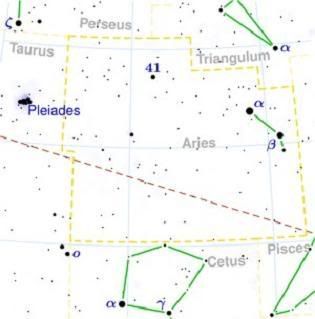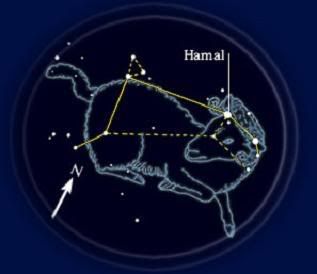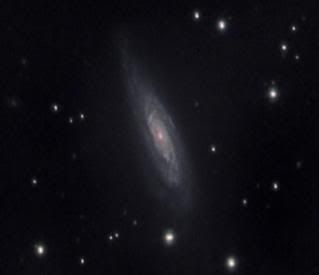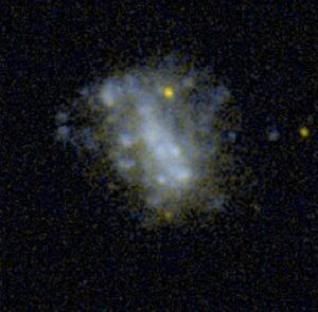Post by glactus on Feb 17, 2008 10:50:38 GMT


The Ram
Aries the ram is one of the least conspicuous of the zodiacal constellations, and has only two stars above third magnitude. These are Hamal and Sheratan, the Alpha and Beta stars of the constellation. Unusually, these two stars not only appear to be close together in the sky, but actually are: they lie just six light years from one another. But this constellation has other things of merit, "the firstpoint of Aries"
The First Point of Aries is a place of vital importance in the sky - here, the Ecliptic and the Celestial Equator cross, and when the Sun reaches this point, as it does once a year, the Vernal Equinox occurs. The First Point of Aries also marks the Celestial Meridian, which is the zero-point for calculations of Right Ascension.
Notable stars
Alpha Arietis (Hamal) - with a magnitude of 2.3, Hamal translates into "The head of the sheep", and is the brightest star of the constellation. It shines with a reddish color and is some 55 times brighter and five times more massive than our Sun.
Beta Arietis (Sheratan) - Beta shines at magnitude 2.7 and it is located 60 light years from Earth. In the early 1900's it was discovered to be a spectroscopic binary, with a period of 106 days.
Lambda Arietis - A binary star easily split with binoculars into its components of magnitudes 5 and 7. It is approximately 133 light years from Earth.
Notable objects:

NGC 772
NGC 772 - A faint spiral galaxy visible with a 4.5-inch telescope as a small hazy patch only 5x3 arcminutes across. Users of larger telescopes might notice a spiral arm in the northwestern part of the galaxy. It is 130 million light years away and has a magnitude of 11.2

NGC 697
NGC 697 is a mag. 13.3 galaxy classifed as SBb-c. This galaxy is part of a group of five plus galaxies known as the NGC 697 group.

NGC 1156
NGC 1156 is a dwarf irregular galaxy of the type Ibm. It is considered a Magellanic-type irregular. The galaxy has a larger than average core, and contains zones of contra-rotating gas. The counter-rotation is thought to be the result of tidal interactions with another gas rich galaxy some time in the past. Magnitude is 11.7.

The cosmos
credits:
Aries map and major text: wikipedia
en.wikipedia.org/wiki/Aries_(constellation)
ram map:
www.novareinna.com/constellation/ariesheaven.html
image: NGC772, NGC 697, NGC 1156
www.spiral-galaxies.com/Galaxies-Aries.html


